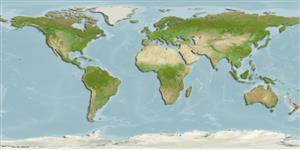Teleostei (teleosts) >
Aulopiformes (Grinners) >
Paraulopidae (Cucumber fishes)
Etymology: Paraulopus: Paraulopus refers to a taxon related to Aulopus, both being included in the Aulopiformes.
Eponymy: Dr Osamu Okamura was Professor Emeritus at the Laboratory of Natural Science, Kochi University, where he was Professor of Zoology (1989). [...] (Ref. 128868), visit book page.
Environment: milieu / climate zone / depth range / distribution range
Ecology
Marine; bathydemersal; depth range ? - 478 m (Ref. 46206). Deep-water
Southwest Pacific: north of New Zealand.
Size / Weight / Age
Maturity: Lm ? range ? - ? cm
Short description
Identification keys | Morphology | Morphometrics
Anal soft rays: 9 - 11. This species is characterized by the following: A 9-11, rarely 9; pectoral fin rays 16-17; black-and-white-patterned dorsal and caudal fins; side of the body of adults with small brown blotches midlaterally and a smaller brownish saddle behind the adipose fin; interior of the mouth entirely pale (Ref. 86263).
Minimum depth from Ref. 58018.
Life cycle and mating behavior
Maturity | Reproduction | Spawning | Eggs | Fecundity | Larvae
Eschmeyer, W.N. (ed.), 2003. Catalog of fishes. Updated database version of March 2003. Catalog databases as made available to FishBase in March 2003. (Ref. 46206)
IUCN Red List Status (Ref. 130435: Version 2024-1)
Threat to humans
Harmless
Human uses
Tools
Special reports
Download XML
Internet sources
Estimates based on models
Preferred temperature (Ref.
123201): 12.2 - 16, mean 13 °C (based on 6 cells).
Phylogenetic diversity index (Ref.
82804): PD
50 = 0.5001 [Uniqueness, from 0.5 = low to 2.0 = high].
Bayesian length-weight: a=0.00389 (0.00180 - 0.00842), b=3.12 (2.94 - 3.30), in cm total length, based on all LWR estimates for this body shape (Ref.
93245).
Trophic level (Ref.
69278): 3.9 ±0.7 se; based on size and trophs of closest relatives
Fishing Vulnerability (Ref.
59153): Low vulnerability (12 of 100).
